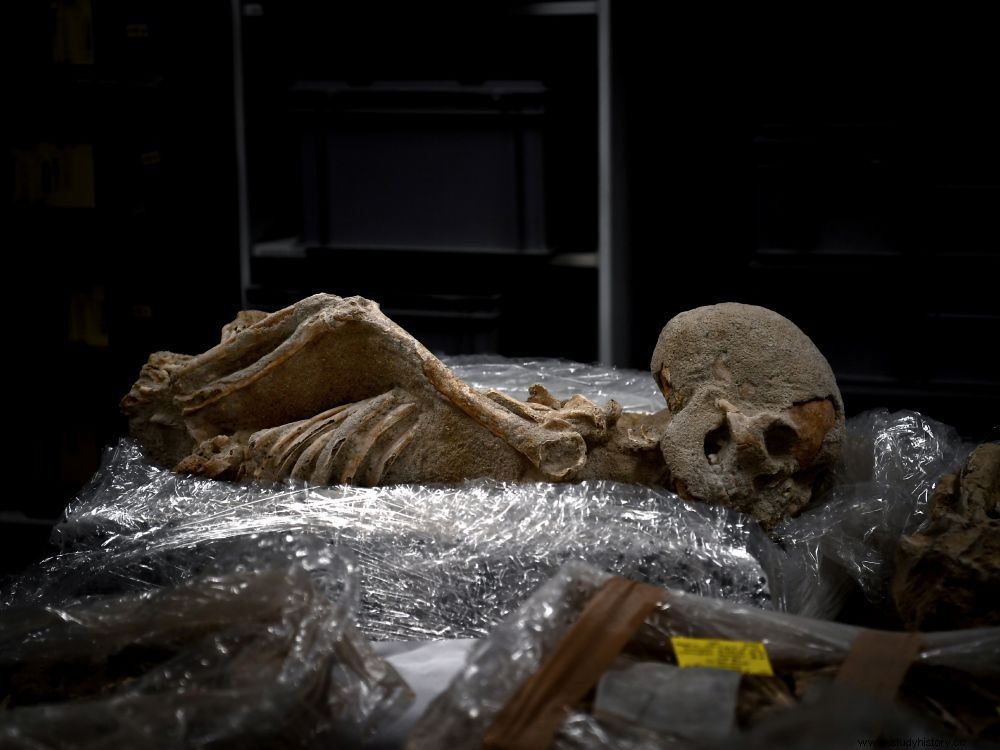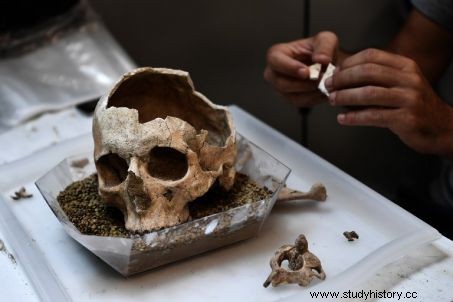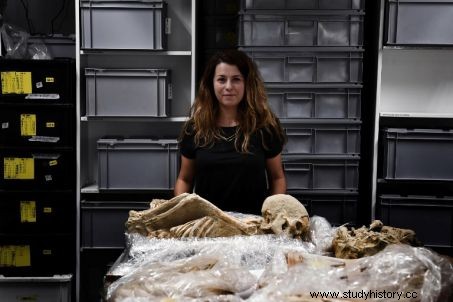A hundred chained skeletons have been unearthed in an Athens necropolis. Archaeologists try to solve the secret of their execution.

The human skeletons were transferred to a laboratory at the American School of Archeology in Athens on July 7, 2017-
Who were they and why were they killed? In Athens, an investigation was opened after the discovery of a hundred skeletons bearing the signs of a violent death which occurred more than 2,500 years ago. The crime scene:a vast necropolis used from the 8th to the 5th century BC. AD in the seaside district of Phaleron, the ancient port of the Greek city. There, no monuments or epigraphs as in the other ancient Athenian cemetery of Ceramics, but simple tombs dug in sandy soil, alongside, in an apparent disorder, the remains of funeral pyres and jars, the "coffins" of the time for newborns and young children.

A skull being examined. Credit:ARIS MESSINIS / AFP.
Clearly, victims of a "political execution"
It is in this site intended for those without grades in great history - unlike the Ceramics at the foot of the Acropolis - that archaeologists have unearthed strange skeletons since 2012. Hands tied, behind their backs or on their stomachs, their feet sometimes shackled, some even rested face down on the ground as if in ultimate outrage. The finds culminated in the spring of 2016 with the opening of a tomb containing the remains of 80 chained men, an “unparalleled” find in Greece, according to the archaeologist in charge of the excavations, Stella Chrysoulaki.
Young and well-fed, according to the first clues provided by their teeth, they were lined up in three rows, some on their backs, others on their stomachs, fifty-two of them lying with their arms raised. Completed with a blow to the skull, they were clearly the victims of a "political execution", which could be dated, according to two pots found in the tomb, from 675 to 650 years BC. J.-C., explains Ms. Chrysoulaki. This period "is that of the formation of the city-state and the transition to democracy, against a backdrop of strong political unrest, tensions between tyrants, aristocrats and working classes", notes bioarchaeologist Eleanna Prevedorou, who is leading the investigation. "medico-legal" on these ancient deaths at the American School of Archeology in Athens.
Cylon supporters?
According to a hypothesis considered by archaeologists, based on the accounts of ancient authors Herodotus and Thucydides, the deceased could be the supporters of the aristocrat and ex-Olympic champion Cylon, massacred by the powerful rival clan of the Alcmaeonids after a failed attempt to impose a tyranny. In an attempt to solve the case, "we're going to use basically all the methods made famous by forensic science television series" , laughs Panayotis Karkanas, director of the ultra-modern Malcom Wiener laboratory housed by the American School.

bioarchaeologist Eleanna Prevedorou in front of human skeletons in a laboratory at the American School of Archeology in Athens. Credit: ARIS MESSINIS / AFP.
A battery of analyses, genetic, radiographic, isotopic... must be deployed to collect all the clues:ages, possible family ties, geographical origins, state of health, socio-economic level. The project, which promises to be a long-term one - from five to seven years - includes all the other dead of the necropolis, that is to say more than a thousand in total, whose skulls, femurs or thoraxes are piled up to the ceiling in laboratory supplies.
Skeletons versus 'fake news'
In one corner, a skeleton with arms twisted behind its back bears witness to ancient violence, a far cry from the idealized representations of Greek classicism:it could be a "captive of war, a criminal or a rebellious slave", explains Mrs Prevedorou. Ten of the "80 in chains" are to join him in the laboratory by the fall, their companions in misfortune remaining on site for a future exhibition of their last home, within the walls of the Niarchos du Phalere cultural center.
Even the apparently uneventful dead, and in particular the hundreds of young children found in the funeral jars, will be able to talk about their lifestyles, their illnesses, throwing more light on archaic Athens, notes Mr. Karkanas. By working as closely as possible to man and his natural environment, bioarchaeology is, according to him, irreplaceable for retracing the daily lives of ordinary ancient characters. Written and monumental sources, in any case rarer for the archaic period, testify above all to the history of "elites and victors". Referring only to these to decipher the past would be like "trusting only the newspapers today to know what is happening in the world" , he adds.
